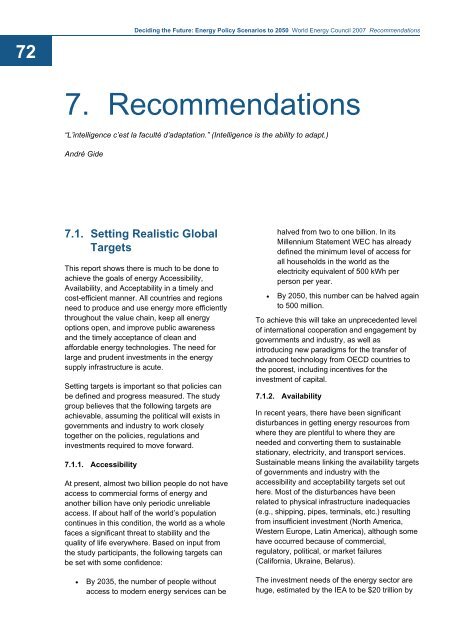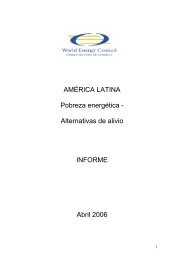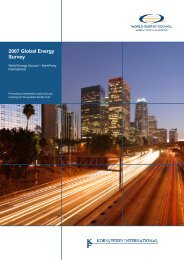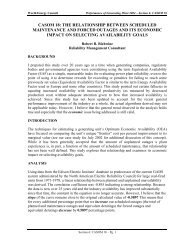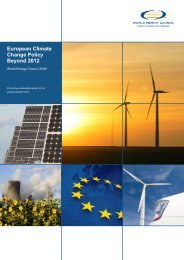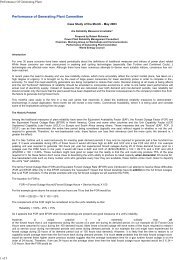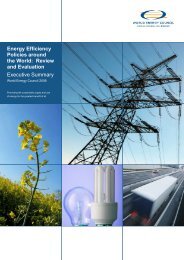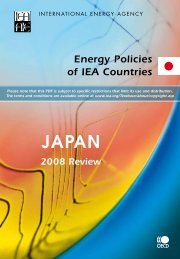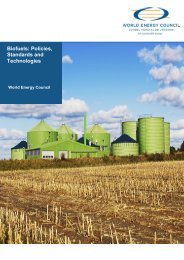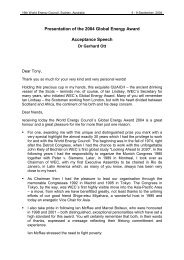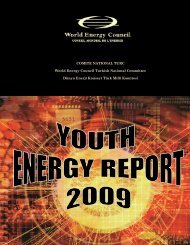Deciding the Future: Energy Policy Scenarios to 2050
Deciding the Future: Energy Policy Scenarios to 2050
Deciding the Future: Energy Policy Scenarios to 2050
You also want an ePaper? Increase the reach of your titles
YUMPU automatically turns print PDFs into web optimized ePapers that Google loves.
72<br />
<strong>Deciding</strong> <strong>the</strong> <strong>Future</strong>: <strong>Energy</strong> <strong>Policy</strong> <strong>Scenarios</strong> <strong>to</strong> <strong>2050</strong> World <strong>Energy</strong> Council 2007 Recommendations<br />
7. Recommendations<br />
“L’intelligence c’est la faculté d’adaptation.” (Intelligence is <strong>the</strong> ability <strong>to</strong> adapt.)<br />
André Gide<br />
7.1. Setting Realistic Global<br />
Targets<br />
This report shows <strong>the</strong>re is much <strong>to</strong> be done <strong>to</strong><br />
achieve <strong>the</strong> goals of energy Accessibility,<br />
Availability, and Acceptability in a timely and<br />
cost-efficient manner. All countries and regions<br />
need <strong>to</strong> produce and use energy more efficiently<br />
throughout <strong>the</strong> value chain, keep all energy<br />
options open, and improve public awareness<br />
and <strong>the</strong> timely acceptance of clean and<br />
affordable energy technologies. The need for<br />
large and prudent investments in <strong>the</strong> energy<br />
supply infrastructure is acute.<br />
Setting targets is important so that policies can<br />
be defined and progress measured. The study<br />
group believes that <strong>the</strong> following targets are<br />
achievable, assuming <strong>the</strong> political will exists in<br />
governments and industry <strong>to</strong> work closely<br />
<strong>to</strong>ge<strong>the</strong>r on <strong>the</strong> policies, regulations and<br />
investments required <strong>to</strong> move forward.<br />
7.1.1. Accessibility<br />
At present, almost two billion people do not have<br />
access <strong>to</strong> commercial forms of energy and<br />
ano<strong>the</strong>r billion have only periodic unreliable<br />
access. If about half of <strong>the</strong> world’s population<br />
continues in this condition, <strong>the</strong> world as a whole<br />
faces a significant threat <strong>to</strong> stability and <strong>the</strong><br />
quality of life everywhere. Based on input from<br />
<strong>the</strong> study participants, <strong>the</strong> following targets can<br />
be set with some confidence:<br />
• By 2035, <strong>the</strong> number of people without<br />
access <strong>to</strong> modern energy services can be<br />
halved from two <strong>to</strong> one billion. In its<br />
Millennium Statement WEC has already<br />
defined <strong>the</strong> minimum level of access for<br />
all households in <strong>the</strong> world as <strong>the</strong><br />
electricity equivalent of 500 kWh per<br />
person per year.<br />
• By <strong>2050</strong>, this number can be halved again<br />
<strong>to</strong> 500 million.<br />
To achieve this will take an unprecedented level<br />
of international cooperation and engagement by<br />
governments and industry, as well as<br />
introducing new paradigms for <strong>the</strong> transfer of<br />
advanced technology from OECD countries <strong>to</strong><br />
<strong>the</strong> poorest, including incentives for <strong>the</strong><br />
investment of capital.<br />
7.1.2. Availability<br />
In recent years, <strong>the</strong>re have been significant<br />
disturbances in getting energy resources from<br />
where <strong>the</strong>y are plentiful <strong>to</strong> where <strong>the</strong>y are<br />
needed and converting <strong>the</strong>m <strong>to</strong> sustainable<br />
stationary, electricity, and transport services.<br />
Sustainable means linking <strong>the</strong> availability targets<br />
of governments and industry with <strong>the</strong><br />
accessibility and acceptability targets set out<br />
here. Most of <strong>the</strong> disturbances have been<br />
related <strong>to</strong> physical infrastructure inadequacies<br />
(e.g., shipping, pipes, terminals, etc.) resulting<br />
from insufficient investment (North America,<br />
Western Europe, Latin America), although some<br />
have occurred because of commercial,<br />
regula<strong>to</strong>ry, political, or market failures<br />
(California, Ukraine, Belarus).<br />
The investment needs of <strong>the</strong> energy sec<strong>to</strong>r are<br />
huge, estimated by <strong>the</strong> IEA <strong>to</strong> be $20 trillion by


